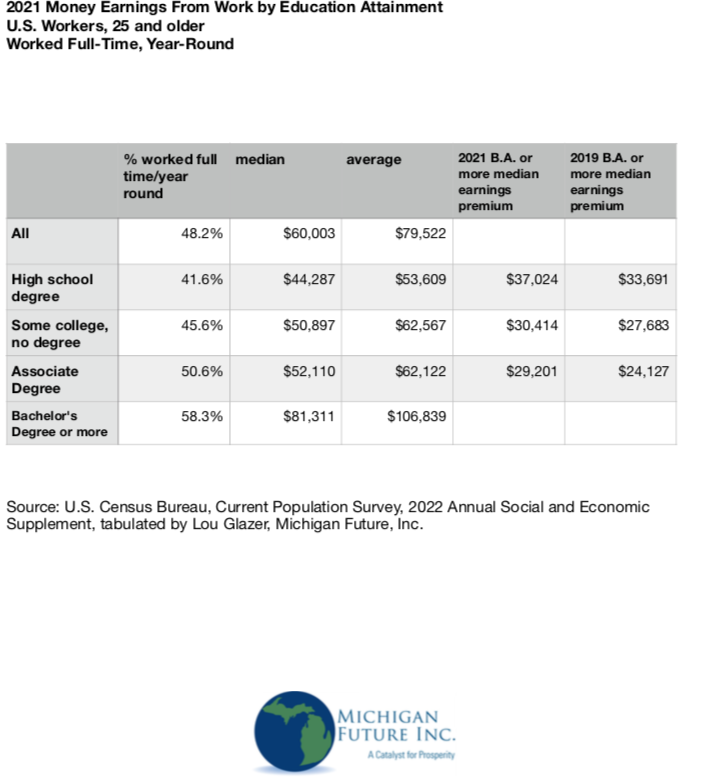
Increasingly our public conversation is dominated by claims that workers can do just as well without a four-year degree as with one. As we have explored frequently, pre pandemic––in both good and bad economic times––that simply was not accurate. Those with a four-year degree or more over a forty-year career worked more and earned more than those with less education attainment.
This post explores whether that reality holds true in the post pandemic labor market. Did workers with a B.A. in 2021 work more and earn more than those with less than a B.A.? The data come from the U.S. Census Bureau’s table on money earnings from work by education attainment.
The data allow us to look at what workers earned from all work in 2021. Where some worked in one job, others worked more than one job. Where some worked in payroll jobs, some in gig jobs, some self employed. Where some earned overtime pay and others got bonuses from work.
We looked at data for the 109 million U.S. workers 25 and older who worked full time and year round in 2021. Our findings are displayed in the table at the bottom of this post.
Let’s start our look at the data with the proportion of people who worked full time and year round in 2021 by education attainment. As you can see in the table below, the higher the education attainment the higher proportion of those who worked full time and year round in 2021. Ranging from 41.6 percent for those with a high school degree to 58.3 percent for those with a four-year degree or more.
Now let’s look at money earnings for those who worked full time and year round in 2021. For both median and average work earnings, the higher the education attainment the more you earned. With the most significant gap being between those with a B.A. or more and those with an associate degree or less. Median work earnings ranged from $44,287 for those with a high school degree to $81,311 for those workers with a four-year degree or more. Average money earnings from work ranged from $53,609 for those with a high school degree to $106,839 for those workers with a four-year degree or more.
The reason why average work earnings premium for those with a B.A. or more is so much higher than the median is that high-wage earners are dominated by those with a B.A. or more. Once again contrary to conventional wisdom which tells us there are lots of jobs that pay six figures that don’t require a B.A. The reality is that in the post-pandemic labor market those earning six figures overwhelmingly had a B.A. or more: 18.9 million of the 24.5 million.
Those with a B.A. or more are 37.7 percent of Americans 25 and older; 45.5 percent of those who worked full time and year round; and 77.1 percent of those with work earnings of $100,000 or more.
The last two columns in the table below look at the work earnings premium for those with a B.A. or more compared to those with less education attainment in the pre-pandemic 2019 labor market and the post-pandemic 2021 labor market. As you can see the median work earnings premium increased across the board. Growing from $33,691 to $37,094 compared to high school graduates. Growing from $27,683 to $30,414 compared to those with some college, no degree. And growing from $24,127 to $29,201 compared to those with an Associate Degree.
The data are confirming of the reality that the most reliable path to middle class and above jobs and careers is by having a B.A. or more. This was the Michigan reality before the pandemic, during the pandemic and post pandemic.








